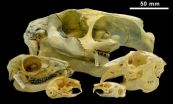(Press-News.org) VIDEO:
A 10-day-old zebrafish gets its stripes over the next 30 days, one image taken a day.
Click here for more information.
Within weeks of publishing surprising new insights about how zebrafish get their stripes, the same University of Washington group is now able to explain how to "erase" them.
The findings – the first published Aug. 28 in Science and the latest in the Nov. 6 issue of Nature Communications – give new understanding about genes and cell behaviors that underlie pigment patterns in zebrafish that, in turn, could help unravel the workings of pigment cells in humans and other animals, skin disorders such as melanoma and cell regeneration.
"Using zebrafish as a model, we're at the point where we have a lot of the basic mechanisms, the basic phenomenology of what's going on, so we can start to look at some of these other species that have really different patterns and start to understand them," said David Parichy, a UW professor of biology and corresponding author on both papers.
Zebrafish, a tropical freshwater fish about 1.5 inches long, belongs to the minnow family and is a popular addition to home aquariums. Adults have long horizontal blue stripes on their sides, hence the reference to "zebra." These patterns have roles in schooling, mate selection and avoiding predators. Given their importance, scientists have long wanted to know where these pigment cells come from and how they make stripes and other arrangements.
Unlike humans with a single pigment cell type – the amount of melanin that produces color being determined by everyone's individual genetics – there are three pigment cells that make the zebrafish pattern.
Researchers at UW and elsewhere have previously shown that all three types of pigment cells communicate with one another to organize zebrafish stripes and that two of the pigment cells – one that creates black and another silver – come from stem cells.
In the Aug. 28 issue of Science, two papers report that the cells called xanthophores that produce the color orange don't come from stem cells as had long been assumed. Instead, they come from pre-existing cells in the embryo. The UW researchers also determined the surprising process by which this occurs: cells in the embryo first mature into xanthophores and then, when it's time to make stripes, these same cells lose their color, increase in number and then turn back into xanthophores with color.
"This is remarkable because cells do not normally lose their mature properties, let alone regain them later," Parichy said. "Knowing how xanthophores achieve this feat could provide clues to regeneration of tissues and organs without the need for stem cells."
Even more remarkably, the UW authors found that the re-development of orange-producing xanthophores requires thyroid hormone, the same hormone that turns tadpoles into frogs, suggesting that xanthophores undergo their own metamorphosis. At the same time thyroid hormone blocks development of the black cells, setting the proper shade overall.
"In the last 10 to 15 years people trying to understand these patterns have concentrated on how the three pigment cell types interact with each other. We showed the tremendous dependence on thyroid hormone for the pattern that develops," Parichy said.
Lead author is Sarah McMenamin, a postdoctoral fellow in Parichy's lab. Funding for the work was provided by the National Institutes of Health, which just awarded Parichy a new $1.25 million grant to study thyroid hormone signaling in pigmentation and melanoma.
Next in the Nature Communications paper, Parichy's group reports on a gene that drives the unusually early appearance of xanthophores – independent of thyroid hormone – in another species, the pearl danio. Unlike zebrafish this species lacks stripes: its pigment cells are intermingled and arranged uniformly on the body, giving it a pearly orange color.
By expressing this gene the same way in zebrafish, the researchers caused the fish to make extra-early xanthophores and the fish produced a uniform pattern like the pearl danio instead of their usual stripes.
"Really simple changes in timing make totally different patterns," Parichy said.
This unexpected result shows that a core network of interacting cells can generate very different patterns in response to changes in timing, a discovery that could explain color pattern evolution across a variety of species. Lead author on the Nature Communications paper is postdoctoral scholar Larissa Patterson and the work was funded by the NIH.
"If you'd asked me five years ago if we're in a position to have some useful hypotheses about where patterns come from in other species, I'd have said, 'No,'" Parichy said. "But I think now we're really at the point where we understand a lot of the basics and we can start to frame testable hypotheses. We can see how much of this is just a simple difference in timing, a difference in thyroid hormone responsiveness or a difference in cellular communication itself."
INFORMATION:
Patterson and UW's Emily Bain are co-authors on both papers. Other co-authors on the Science paper are UW's Anna McCann, Dae Seok Eom, and undergraduates Zachary Waller and James Hamill, as well as Julie Kuhlman from Iowa State University and Judith Eisen of the University of Oregon.
For more information you can contact Parichy at dparichy@uw.edu or 206-734-7331.
Suggested Websites
"Thyroid hormone–dependent adult pigment cell lineage and pattern in zebrafish"
Aug. 28, 2014, Science online:
http://www.sciencemag.org/content/345/6202/1358.abstract
"Pigment-cell interactions and differential xanthophores recruitment underlying zebrafish stripe reiteration and Danio pattern evolution"
Scheduled for Nov. 6, 2014, Nature Communications:
http://www.nature.com/naturecommunications
Parichy lab:
http://faculty.washington.edu/dparichy/Index.html
Berlin, Germany (November, 2014) – Closely related groups can differ dramatically in their diversity, but why this happens is a fundamental question in evolutionary biology, dating back to Darwin's observation that a few hyper-diverse groups dominate the modern biota. One of the most extreme examples of this observation is found in the comparison of rodents (Rodentia) and rabbits (Lagomorpha). These two mammalian orders are sister groups, but while rodents have diversified to over 2000 living species and an enormous range of body sizes, lagomorphs (rabbits, hares, ...
ATLANTA, GA (November 7, 2014) – Many people don't realize allergies and asthma go hand-in-hand, and about 90 percent of kids with asthma also have allergies. Even more important, when asthma is undiagnosed or poorly controlled, children are at risk for suffering difficult-to-treat allergic reactions to food.
According to a study presented at the American College of Allergy, Asthma and Immunology (ACAAI) Annual Scientific Meeting, a two and-a-half year-old girl in Pennsylvania suffered a life-threatening allergic reaction (anaphylaxis) to eating an orange – ...
WHITE PLAINS, N.Y., Nov. 6, 2014 – The national preterm birth rate fell to 11.4 percent in 2013 – the lowest in 17 years -- meeting the federal Healthy People 2020 goal seven years early. Despite this progress, the U.S. still received a "C" on the 7th annual March of Dimes Premature Birth Report Card because it fell short of the more-challenging 9.6 percent target set by the March of Dimes, the group said today.
"Achieving the Healthy People 2020 goal is reason for celebration, but the U.S. still has one of the highest rates of preterm birth of any high ...
WASHINGTON - Airport security agents using a new conversation-based screening method caught mock airline passengers with deceptive cover stories more than 20 times as often as agents who used the traditional method of examining body language for suspicious signs, according to new research published by the American Psychological Association.
In experiments spanning eight months, security agents at eight international airports in Europe detected dishonesty in 66 percent of the deceptive mock passengers using the new screening method, compared to just 3 percent for agents ...
New Rochelle, NY, November 6, 2014—Screening large cell culture collections containing plant samples obtained from diverse geographic regions, climates, and soil and growing conditions for biological activity can reveal a wealth of natural compounds with potential applications for crop improvement and protection. The capability to do reproducible screening and genomic analysis of the more than 2,000 plant cell lines maintained in culture at the Institute of Cell Biology and Genetic Engineering, in Kiev, Ukraine is describe in an article in Industrial Biotechnology, ...
A recently launched European satellite could reveal tens of thousands of new planets within the next few years, and provide scientists with a far better understanding of the number, variety and distribution of planets in our galaxy, according to research published today.
Researchers from Princeton University and Lund University in Sweden calculated that the observational satellite Gaia could detect as many as 21,000 exoplanets, or planets outside of Earth's solar system, during its five-year mission. If extended to 10 years, Gaia could detect as many as 70,000 exoplanets, ...
November 5, 2014, Hong Kong, China –Today, the international open-access open-data journal GigaScience (a BGI and BioMed Central journal) announced publication of an article that presents GWATCH1, a new web-based platform that provides visualization tools for identifying disease-associated genetic markers from privacy-protected human data without risk to patient privacy. This dynamic online tool, developed by an international team of researchers from Russia, Australia, Canada, and the US, allows and facilitates disease gene discovery via automation and presentation ...
Fast, on-the-spot tests for bacterial infections may help to reduce excessive antibiotic use. A systematic review published in The Cochrane Library, found that when doctors tested for the presence of bacterial infections they prescribed fewer antibiotics.
Antibiotics treat infections caused by bacteria but not those caused by viruses. Most patients who visit their doctors with acute respiratory infections are suffering from viral infections like the common cold. However, because doctors usually have no immediate way of knowing whether an infection is bacterial or viral, ...
Teenagers are much more likely to take up smoking if they live in neighbourhoods with a large number of shops that sell tobacco products, a study suggests.
Adolescents with the most tobacco outlets in their neighbourhood are almost 50% more likely to smoke than those with no outlets nearby, researchers say.
The study also found that teenagers living in areas with the highest density of retailers are 53 per cent more likely to try smoking at least once.
Based on their findings, researchers argue that anti-smoking strategies among teenagers should include reducing ...
PRINCETON, N.J.—Life satisfaction dips around middle age and rises in older age in high-income, English-speaking countries, but that is not a universal pattern, according to a new report published in The Lancet as part of a special series on ageing. In contrast, residents of other regions — such as the former Soviet Union, Eastern Europe, Latin America and sub-Saharan Africa — grow increasingly less satisfied as they age.
The study — conducted by researchers from Princeton University's Woodrow Wilson School of Public and International Affairs, ...








